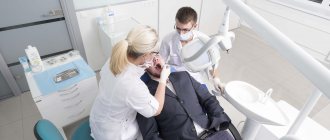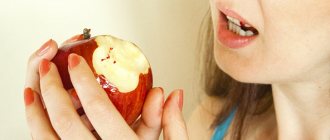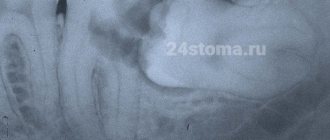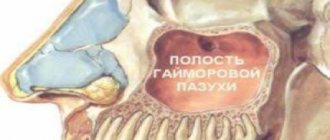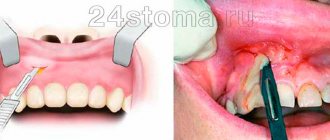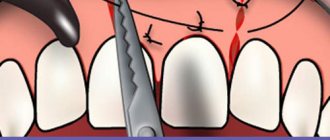Causes of pain after removal
The severity of pain depends on the complexity of the operation performed. Normally, pain may occur immediately after the anesthetic wears off, and discomfort may persist for 2-3 days. Then the symptom should subside. Sometimes dentists allow pain to persist for five days, but in the absence of other complaints.
The main cause of pain in the socket area after wisdom tooth removal is alveolitis. Inflammation of the socket develops for the following reasons:
- Highly traumatic surgical procedure.
- Incomplete sanitation of the hole, preservation of tooth fragments in it.
- Injuries to the mucous membrane during surgery, for example, with a bur when dividing roots or with forceps when applying cheeks to the walls of a tooth.
- Refusal to apply sutures if there are direct indications for the procedure.
- No course of antibiotics after complex tooth extraction.
Characteristic will be an increase in pain and the addition of other signs of inflammation. The only right decision in this situation is to visit the dentist.
Why do wisdom teeth hurt?
The appearance of a figure eight is often accompanied by fever, pain radiating to the ear, neck, enlarged submandibular lymph nodes, swelling and redness of the gums. There are many reasons why a wisdom tooth hurts; painful eruption is often associated with the following situations:
- Formation of the “hood”
- in an adult, the gum tissue is denser than in a child. Because of this, cutting through the figure eight is difficult. When only part of the tooth has erupted, and the other still remains under the gum, a section of tissue covering the erupted crown forms a specific hood. It makes further eruption of the molar difficult. The cause of pain in this situation is the inflammatory process developing under the hood (pericoronitis). - Abnormal growth
– figure eights often grow incorrectly relative to the jaw arch. Since the dentition is formed, there is not enough space for the figure eight. It begins to grow towards the neighboring unit, and the pain covers not only the area of the erupting tooth, but the entire jaw.
If a wisdom tooth that has already erupted begins to hurt, the reasons are most often the following:
- Caries
– the outer molars are located in a hard-to-reach area; it is difficult to clean them well with a brush. Bacterial plaque accumulates more in this area, causing caries. - Pulpitis -
a carious lesion extends beyond the enamel, dentin, and affects the tissue of the pulp chamber (neurovascular bundle). Pulpitis is accompanied by severe, throbbing pain. Endodontic treatment of figure eights does not differ from the techniques applied to other dental units. - Periodontitis is
inflammation of the tissue around the tooth root. It can be acute or chronic. The cause of the development of periodontitis is untreated pulpitis, trauma to the eighth molar, depressurization of a previously filled root canal and penetration of infection into it, and incorrect position of the tooth in the row.
Unpleasant sensations can intensify with the development of diseases of the oral cavity, infection of the dental canals, the formation of cysts, and granulomas. If your wisdom tooth hurts badly, you should immediately consult a dentist.
Causes of swelling after removal
Swelling of the mucous membrane in the area of removal in the gum area, as well as swelling of the cheeks, are also considered normal after wisdom tooth extraction. This is explained by tissue injury and the body’s natural reaction to the procedure. Normally, swelling increases the next day after visiting a dental surgeon, but then, if all recommendations are followed, it should subside.
If the swelling continues to increase, you should consult a doctor. The same applies to situations where, in addition to tissue swelling, there is increased pain, discharge from the socket, and increased body temperature. The listed signs indicate inflammation, which requires initiation of treatment.
The signs will be especially pronounced if there was already purulent inflammation at the time of visiting the dentist. In this case, even a correctly performed procedure, creating an outflow of inflammatory exudate, does not exclude an increase in tissue edema. When removing the upper tooth, swelling may spread to the orbital area. During surgery on the third molar of the mandible, swelling may extend to the neck and ear area. If after a day the symptom becomes less pronounced, we can assume that there are no complications.
In addition to increased swelling and pain, the following signs will be an indication for an emergency visit to the dentist:
- Discharge of pus from the socket.
- Bleeding.
- Pain when swallowing.
- Pain when trying to open your mouth.
- Swelling of the face, accompanied by redness of the skin.
It is unlikely that tissue swelling will be completely avoided, but the risk of complications can be reduced. It is enough to follow the doctor’s instructions, take prescribed medications and monitor oral hygiene.
What to do before deleting the eight
There are a number of rules to make surgery safer and reduce the risk of postoperative complications. Among them:
- Eat one to three hours before visiting the dentist (but if general anesthesia is planned, you cannot eat!). A preliminary meal before extraction, performed under local anesthesia, promotes better blood clotting and improves the patient’s physical condition.
- Carry out removal in the first half of the day (preferably in the morning). In the morning hours, the human body copes better with stressful situations. In addition, if the procedure is scheduled for the evening, the patient may experience insomnia due to persistent pain and nervous tension.
- Do not drink alcoholic beverages on the eve of surgery. They negatively affect the rheological properties of blood, which means that the risk of swelling and bleeding will increase.
- In case of severe anxiety, take a sedative of herbal origin. It is important that the person is not allergic to the drug used.
To remove the figure eight, you need to choose a clinic and a dental surgeon whose reputation is beyond doubt. Then the patient will be able to relax better, which means the procedure will be more comfortable.
How long does it take for the mucous membrane to heal after removal?
The duration of the healing process depends on a large number of factors. First of all, the difficulty of removal matters. The removal technique also has an effect, that is, extirpation of the roots in parts, cutting of the tooth. It is important to take into account the initial condition when visiting the dentist. The hole will take longer to heal if the tooth is located outside the dental arch, grew in the jaw at an angle, or was located horizontally in the dentition. The presence of an inflammatory process near the tooth, especially signs of purulent inflammation and pericoronitis, also increases the healing period.
When sutures are applied after a simple removal, within a week the patient will forget about the procedure, but it is too early to think about prosthetics or implantation. With complex removal, the healing process will take slightly longer. If complications arise after surgical treatment, wound sanitation, treatment, and suturing are required, then the time for complete healing may increase to 20 days. Complete restoration of the mucosa takes at least three weeks. Only after this can implantation and prosthetics be performed in the area of the removed wisdom tooth.
Normally, gums must go through several stages:
When going to the dentist, it is recommended to immediately plan your day. This is especially true if there are already signs of inflammation or the teeth are severely damaged, that is, a difficult extraction is expected. Recommendations after wisdom tooth removal include, first of all, complete rest on the day after surgery. You should not make sudden movements, bend over, visit baths and saunas, or take a hot bath. It is prohibited to play sports or do any work while bending over. The best option would be complete rest. There is no need to do any special procedures on the day of the operation.
Smokers are advised to abstain from cigarettes if possible for three days or more if there are signs of complications. Nicotine causes vasoconstriction and disrupts tissue nutrition, which slows down regeneration processes. In addition, the risk of wound infection increases.
After a couple of days, you should visit the dentist who performed the procedure to assess the condition of the tissue and the healing process. This must be done even if the patient is not bothered. If signs of complications appear, pain and swelling increase, and bleeding does not stop, consult a doctor without waiting for the appointed date.
If sutures were placed on the wound, they are removed after 8-10 days, or a follow-up examination is scheduled if self-absorbable material was used for the sutures.
Do not touch the wound or try to remove part of the clot or remnants of the medicine in the form of sponges. This will only worsen the situation and cause complications.
What do we have to do?
On the first day, do not rinse your mouth. From the second day, procedures can be carried out. In this case, you do not need to intensively rinse the contents of the hole; just hold the solution on the sore side for a few seconds and spit. You need to repeat the procedure several times a day, especially after meals.
Chlorhexidine, furatsilin, miramistin, and potassium permanganate can be used as a rinsing solution. It is also possible to use herbal decoctions, for example, sage, chamomile, calendula or dental collection.
Pain may occur after the anesthetic wears off. To eliminate them, the dentist must prescribe analgesics. If there is no prescription, you can take any painkiller that the patient is used to using for pain. If the pain increases and the tablets do not help, you cannot increase the dosage. An increase in symptoms indicates a complication that requires medical intervention.
If you don't want to take medication, you can use a cold compress. These can be ice cubes wrapped in a towel. They need to be applied for several minutes, avoiding hypothermia of nearby organs, in particular the ear and tonsils.
If there is a high risk of inflammation, as well as if there is purulent discharge at the time of surgery, the dentist will definitely prescribe antibiotics. The doctor calculates the name of the drug and duration of use individually.
Features of nutrition after surgery
After wisdom tooth removal, it is forbidden to eat for two hours. If after the specified time the effect of the anesthetic still persists, it is better to wait until sensitivity appears. Eating food with a numb tongue and cheeks can cause injury to the mucous membrane.
On the first day after surgery, you can only eat warm food and drinks. Products should be soft, for example, cereals, chopped soups, yoghurts. Next, you should follow simple recommendations for several days:
- Avoid hot or too cold food.
- Avoid eating hard foods such as crackers and nuts.
- Chew food only on the healthy side so as not to put stress on the wound.
- After eating, be sure to rinse your mouth.
- You can include more fruits and vegetables in your diet to boost immune strength, or supplement with complex vitamins from the pharmacy.
You cannot drink alcoholic beverages. It is also recommended to reduce sweet foods in the first days, as they create a favorable environment for the development of bacteria.
Features of oral hygiene after removal
On the first day after extirpation, you should abandon the usual brushing of your teeth, limiting yourself to a light rinse before going to bed to remove any remaining food. The next day, you are allowed to use a toothbrush and toothpaste, but the surgical site is treated with special care. When brushing your teeth, do not forget that you cannot actively rinse your mouth. After three days, the wound will have healed and you can return to your usual hygiene regimen and brush your teeth twice a day.
What is recommended for pain relief and healing?
- Apply cold to the outside of your cheek - ice or frozen food will help cope with facial swelling. You should only keep the cold for the first hour or two after removal: 5 minutes each with a 5-minute break.
- If there is bleeding after tooth extraction and the bleeding does not stop (which means either the patient has hypertension or damage to a large vessel during the operation) - do not expect it to stop on its own. Measure your blood pressure. Make a tight sterile gauze swab and press firmly to the wound (it is better to use a hemostatic sponge , you can buy it at the pharmacy). If the bleeding does not stop, and weakness and headache are added to the bleeding, call a taxi to the nearest 24-hour dentist or an ambulance: doctors will put a suture on the wound, which will prevent bleeding.
- It is permissible to take a strong analgesic even before the anesthesia has completely worn off - this will help prevent pain. It is better not to abuse strong painkillers like Ketanov, which has many side effects, but if the operation was complex, you are allowed to take it (the medicine is available by prescription, so it is better to prescribe it from the dentist in advance).
- It is possible to take antiseptic baths three times a day (not rinsing! just hold in your mouth for 1 minute and spit out) with a 0.05% chlorhexidine solution . They are recommended if there was inflammation or flux at the site of the tooth, or if there are other carious cavities in the mouth that can lead to microbes entering the wound. Any antibiotics should be taken only as directed by your doctor.
Why there is bad breath and what to do
The appearance of an unpleasant odor after the removal of a wisdom tooth indicates the development of an inflammatory process. In most cases, the symptom appears 3-4 days after surgery and is accompanied by tissue swelling and pain. In this case, you need to consult a doctor.
Odor may also develop due to lack of hygiene. This increases the risk of inflammatory abs, so you shouldn’t forget about brushing your teeth.
It is worth considering that some medications that doctors use to protect the socket may have a specific odor. As a rule, dentists warn the patient about this situation immediately after the procedure.
Removing a wisdom tooth is a complex procedure, but following all the dentist’s recommendations will help reduce the risk of complications to zero. Our doctors always tell patients in detail the features of the postoperative period and prescribe all prescriptions, including antibiotics and analgesics. All they have to do is follow all the instructions exactly.
What happens in the oral cavity during the extraction of the eighth tooth?
When deciding how to treat a particular patient, the doctor takes into account the characteristics of his physical and emotional state. Particular attention is paid to the presence of allergies to medications.
If there are no contraindications to extraction, the doctor administers an anesthetic. When the area becomes insensitive, the gum bends back and grabs the wisdom tooth with forceps. Begins to make rocking movements, allowing you to loosen the periodontal connection and extract the diseased tooth.
Since during the operation the vessels through which blood flows to the pulp tissues are damaged, bleeding occurs. Nerve impulses indicating trauma are transmitted to the brain. Then pain appears. But due to the action of the anesthetic, the patient does not feel it at first.
The hole formed as a result of the operation is heavily supplied with blood. Leukocytes rush here. Swelling occurs and inflammation develops.
Immediately after surgery, the doctor closes the wound with a sterile cotton swab. It helps stop bleeding and creates conditions for the formation of a dense blood clot. The latter is needed to prevent the penetration of pathogenic microorganisms into the tissues of the wound surface. Do not remove the tampon before the doctor says!



